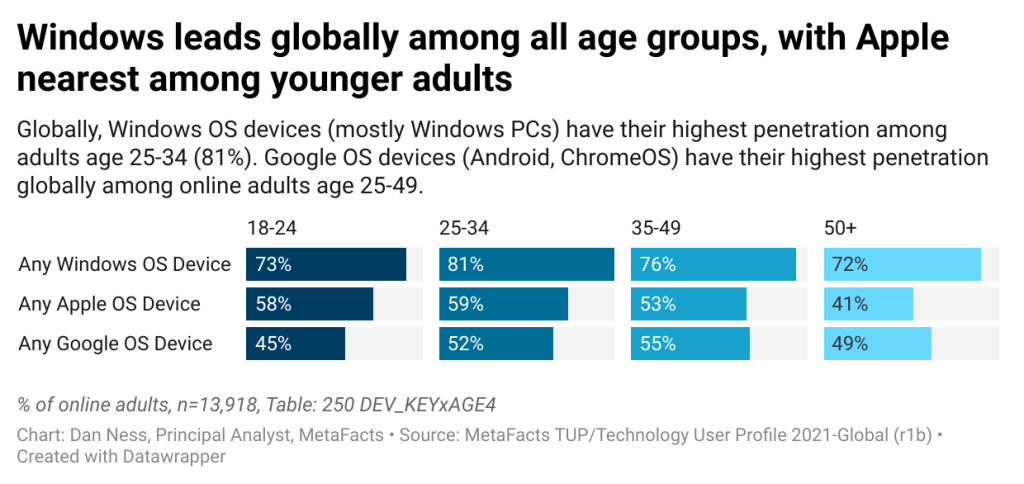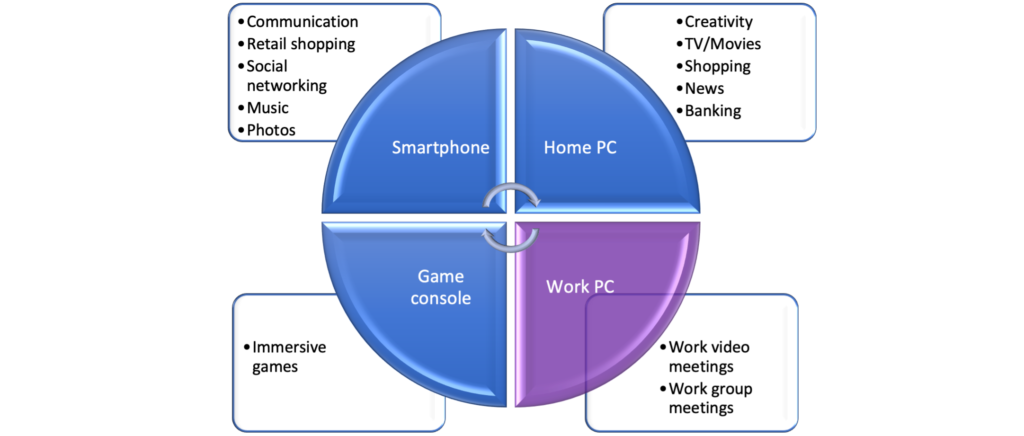VR headsets have received recent attention again after more than a decade of on-again/off-again experimentation with limited market acceptance. While the overall penetration rate of actively-used VR headsets has reached 5% for the first time in 2021, usage rates vary considerably across socioeconomic groups. Having the means to acquire all that’s needed to fully enjoy VR headsets isn’t the only factor affecting adoption as even some upper-income groups are only nominally further ahead than other less advantaged groups. The groups being reported consider age group, employment status, household size, ethnicity, presence of children, educational attainment, and other socioeconomic factors.
User profile by operating system ecosystem
Dan Ness, Principal Analyst, MetaFacts, October 13, 2021
Apple for youngest adults and Windows for the middle
- Windows has the broadest overall market penetration of any OS family
- Globally, Windows is strongest among adults who are employed, in larger households, working from home, and neither the oldest nor youngest
- Apple OS devices have their strongest market penetration among younger adults, especially those employed and working from home
- Apple’s global market penetration is supported in three ways: iPhones, Macs, and iPads
- The global penetration of Google OS devices is primarily supported by Android smartphones.

Technology ecosystem device penetration by country, age, and employment status
One measure of an ecosystem’s breadth is its market penetration. This MetaFAQs splits out the percentage of online adults using major OS families and form factors – such as Windows PCs and iPhones – by country and by age and employment status.
Windows leads what Apple and Google divide [MetaFAQs]
Windows, Apple, and Google (Android, Chromebook) are each stronger or weaker by form factor and country. This MetaFAQs reports on the share of each OS ecosystem by country and within the US, by age group.
Profile of home PC users by brand
The major PC makers have attracted very different sets of customers, with some brands being used primarily by younger people and others more like someone’s father’s brand. This MetaFAQs report profiles the users of home PCs by brand and age group, showing the percentage of users in the US as well as collectively across the US, UK, Germany, and Japan.
Key ecosystems penetration [MetaFAQs]
The market penetration of Windows OS, Apple OS, and Google OS devices varies considerably by country. This MetaFAQs reports on each OS ecosystem’s active market penetration and splits out American users by age group.
PC penetration by socioeconomic groups
How different are advantaged from disadvantaged Americans in whether or not they use a PC, whether personally owned, employer-provided, for self-employment, school, or another one? How much has this changed since before the pandemic? How do historically socioeconomically advantaged groups such as high-income or college graduates compare to disadvantaged groups such as single parents, low-income, less-educated, elderly, or people of color? This TUP analysis reports on the penetration of PCs within each socioeconomic group.
Communication distinctive for remote workers [TUPdate]
Working from home requires more communication than ever, both a broad range of devices (smartphones, computers, tablets), and types (calls, messages, meetings with and without video). Employees working from home use computers for different communication activities than they do with smartphones. This TUPdate compares a detailed list of communication activities among those working from home and those not working from home, and also identifies which devices – PCs, smartphones, or others – are used the most for communication by work from home status.
For most, PCs are first for connecting
Worldwide, smartphones have grown to be the primary device used the most by nearly half of online adults. Among American adults, PC usage continues to lead, although the gap has narrowed.
Activities for PCs versus smartphones
Dan Ness, Principal Analyst, MetaFacts, September 13, 2021
Which device gets chosen for which activities?


